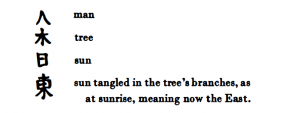The “New Learning” under the ideogram of the mortar1 can imply whatever men of my generation can offer our successors as means to (…) comprehension. (Guide to Kulchur)
ABC of Reading:
Fenollosa’s essay was perhaps too far ahead of his time to be easily comprehended. He did not proclaim his method as a method. He was trying to explain the Chinese ideograph as a means of transmission and registration of thought. He got to the root of the matter, to the root of the difference between what is valid in Chinese thinking and invalid or misleading in a great deal of European thinking and language. The simplest statement I can make of his meaning is as follows: In Europe, if you ask a man to define anything, his definition always moves away from the simple things that he knows perfectly well, it recedes into an unknown region, that is a region of remoter and progressively remoter abstraction. Thus if you ask him what red is, he says it is a ‘colour ‘. If you ask him what a colour is, he tells you it is a vibration or a refraction of light, or a division of the spectrum. And if you ask him what vibration is, he tells you it is a mode of energy, or something of that sort, until you arrive at a modality of being, or non-being, or at any rate you get in beyond your depth, and beyond his depth.
(…)
By contrast to the method of abstraction, or of defining things in more and still more general terms, Fenollosa emphasizes the method of science, ‘which is the method of poetry’, as distinct from that of ‘philosophic discussion ‘, and is the way the Chinese go about it in their ideograph or abbreviated picture writing.
(…)
In tables showing primitive Chinese characters in one column and the present ‘conventionalized’ signs in another, anyone can see how the ideogram for man or tree or sunrise developed, or ‘was simplified from’, or was reduced to the essentials of the first picture of man, tree or sunrise.
Thus:
But when the Chinaman wanted to make a picture of something more complicated, or of a general idea, how did he go about it? He is to define red. How can he do it in a picture that
isn’t painted in red paint? He puts (or his ancestor put) together the abbreviated
pictures of
ROSE CHERRY
IRON RUST FLAMINGO
(…)
The Chinese ‘word’ or ideogram for red is based on something everyone KNOWS. (19-22)
*****
Guide to Kulchur:
The week before last one of the brighter scholars still professed ignorance of the meaning of “ideogramic”. I must try once again to define that term (…) Ernest Fenollosa attacked, quite rightly, a great weakness in western ratiocination. He pointed out that the material sciences, biology, chemistry, examined collections of fact, phenomena, specimens, and gathered general equations of real knowledge from them, even though the observed data had no syllogistic connection one with another. (…) The first knowledge is direct, (…) it affects every perception…
Coming even closer to things (…)
And herein is clue to Confucius’ reiterated commendation of such of his students as studied the Odes. He demanded or commended a type of perception, a kind of transmission of knowledge obtainable only from such concrete manifestation. Not without reason. The whole tone, disposition, Anschauung of Confucius recommending the Odes, of Confucius speaking of music, differs fundamentally (…) from the way the unfortunate (…) occidental usually supposes… (27-29)
The ideogramic method consists of presenting one facet and then another until at some point one gets off the dead and desensitized surface of the reader’s mind, onto a part that will register.(…) To put it yet another way: it does not matter a two-penny damn whether you load up your memory with the chronological sequence of what has happened, or the names of protagonists, or authors of books, or generals and leading political spouters, so long as you understand the process now going on, or [rather] the [plural] processes biological, social, economic now going on, enveloping you as an individual, in a social order, and quite unlikely to be very “new” in themselves however fresh or stale to the participant. (50-51)
CIVILIZATION (…): to define it ideogramicly we may start with the “Listening to Incense”. This displays a high state of civilization. In the Imperial Court of Nippon the companions burnt incense, they burnt now one perfume, and now another, or a mixture of perfumes, and the accomplishment was both to recognize what had gone materially into the perfume and to cite apposite poems. The interest is in the blend of perception [hear/smell] and of association [physical/mental]. It is a pastime neither for clods nor for illiterates. (79)
*****
For Pound (and the same would be true of McLuhan), human beings are directly in touch with the things in their environment. We KNOW things perfectly well. But among the things we KNOW is the fact that the surface of things is not all there is to them. The same sort of direct communication we have with things also holds between their surface and their depth. This is why we can have something like science or why some have what is called ‘deep insight’ into social or historical events.
Understanding the world for Pound and McLuhan presupposed the exercise of both of these kinds of realism.
- The Chinese character for learning. ↩
